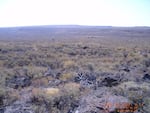
Hart Mountain National Wildlife Refuge
Jonathan Bloomfild / U.S. Fish and Wildlife Service
Federal and state agencies are investigating a string of wildfires in southeastern Oregon with a potential link to military training exercises.
Seven small fires ignited across state and federal lands on July 11, all attributed to human activity — a suspicious pattern that indicates they could be connected, according to federal officials.
“The thing that’s a little bit different with this is the number that occurred simultaneously,” said Brett Fay, Assistant Regional Fire Management Coordinator for the U.S. Fish and Wildlife Service. “Investigations are regular, but the concentration of number of ignitions from this, pretty rare.”
The fires in sage grouse country caught the attention of several agencies: The Fish and Wildlife Service, the Bureau of Land Management, and the Oregon Department of Forestry are all involved in the search for a cause.
The largest of the fires was just over 1,800 acres. All are contained and none did major damage, but the threat of an unknown and unchecked ignition source during the peak of wildfire season has state and federal officials hustling for answers.
“In fire management, we don’t like uncertainty,” Fay said.
Investigators plan to visit the fire locations beginning Tuesday, looking for potential causes. Fay said such fires could be from any number of causes, such as backcountry visitors, power lines, vehicle soot or a vehicle's dragging, sparking chains.
But the preliminary investigation did find one potential cause, according to the Oregon Department of Forestry: military training exercises using incendiary flares.

Two F-15 jets from the Kingsley Air Field fly over Southern Oregon.
Courtesy of the Oregon Military Department
A remnant of a military flare was found at one of the areas burned, triggering a call to the Air National Guard, which uses flares in self-defense training exercises over those same areas that burned. Flares are deployed in air combat to draw heat-seeking missiles away from their targets.
After being contacted by investigators about the fires, the Oregon National Guard agreed to suspend the use of flares. Agencies also engaged them about mitigation techniques to employ if it is determined that the guard was the cause.
But Maj. Stephen Bomar, spokesman for the Air National Guard, said he was skeptical his agency was the source of the fire starts.
“It has been more than 20 years without any sort of flare starting a fire at all in this air space,” Bomar said.
Bomar said photos indicated the specific flare remnant found did appear to be a military flare, but did not match those used by Oregon’s National Guard. He said their flares burn out after 700 feet, and that they don’t drop flares below 5,000 feet to reduce the risk of fires.
“It doesn’t seem to be the Oregon National Guard at this point,” Bomar said.
Other branches of the military, including the Navy and the Idaho National Guard, do utilize airspace in southeastern Oregon for navigation training. Bomar said all of those flights are coordinated out of the Kingsley Air Field in Klamath Falls, which is the only F-15 fighter training facility in the U.S.
Military officials with the Oregon National Guard, the Navy and the Idaho National Guard could not say if any units were training in the area at the time.
The focus on military flares as a wildfire risk in arid southeastern Oregon does not come out of the blue. It has been studied in multiple environmental impact statements as the military changed or expanded its training regimens over the years. Overall, the fire risk from flares is low, particularly with added safety precautions, according to the National Guard.
Federal agencies remained concerned.
In 2015, the U.S. Department of Interior, the U.S. Environmental Protection Agency and Oregon's Department of Fish and Wildlife all warned of potential wildfire risk from flare use, citing species such as sage grouse that could be threatened by loss of habitat from wildfire. All three agencies asked that the Air National Guard restrict its use of flares during periods of "high" fire danger, rather than just during "extreme" fire danger.
In response, the Air National Guard said its analysis showed a minimal risk of fire, and that the difference made by extending a restriction on flares to periods of "high" fire danger was negligible.
Fire danger currently ranges between high and very high throughout most of Eastern Oregon.
Fay said this year’s rains kept the timber wetter than recent years, which can prevent it from burning. But it also meant more grass that turns into fuel for wildfires. Thus far, about 131,000 acres across Oregon and Washington have been affected by wildfire. Last year, over 500,000 acres burned across the two states.
There has also been a high number of human-caused fires this year. Of 894 reported fires, 703 have been human-caused.
